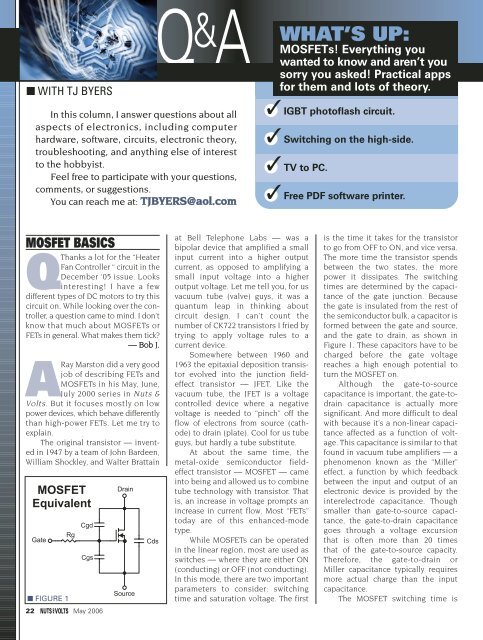You also want an ePaper? Increase the reach of your titles
YUMPU automatically turns print PDFs into web optimized ePapers that Google loves.
■ WITH TJ BYERSQ & AIn this column, I answer questions about allaspects of electronics, including computerhardware, software, circuits, electronic theory,troubleshooting, and anything else of interestto the hobbyist.Feel free to participate with your questions,comments, or suggestions.You can reach me at: TJBYERS@aol.com✓✓✓✓WHAT’S UP:● IGBT photoflash circuit.● Switching on the high-side.● TV to PC.APPLICATIONSMOSFETs! Everything youwanted to know and aren’t yousorry you asked! Practical appsfor them and lots of theory.● Free PDF software printer.MOSFET BASICSQThanks a lot for the “HeaterFan Controller “ circuit in theDecember ‘05 issue. Looksinteresting! I have a fewdifferent types of DC motors to try thiscircuit on. While looking over the controller,a question came to mind. I don’tknow that much about MOSFETs orFETs in general. What makes them tick?— Bob J.ARay Marston did a very goodjob of describing FETs andMOSFETs in his May, June,July 2000 series in <strong>Nuts</strong> &<strong>Volts</strong>. But it focuses mostly on lowpower devices, which behave differentlythan high-power FETs. Let me try toexplain.The original transistor — inventedin 1947 by a team of John Bardeen,William Shockley, and Walter BrattainMOSFETEquivalentGate■ FIGURE 1RgCgdCgs22 May 2006DrainSourceCdsat Bell Telephone Labs — was abipolar device that amplified a smallinput current into a higher outputcurrent, as opposed to amplifying asmall input voltage into a higheroutput voltage. Let me tell you, for usvacuum tube (valve) guys, it was aquantum leap in thinking aboutcircuit design. I can’t count thenumber of CK722 transistors I fried bytrying to apply voltage rules to acurrent device.Somewhere between 1960 and1963 the epitaxial deposition transistorevolved into the junction fieldeffecttransistor — JFET. Like thevacuum tube, the JFET is a voltagecontrolled device where a negativevoltage is needed to “pinch” off theflow of electrons from source (cathode)to drain (plate). Cool for us tubeguys, but hardly a tube substitute.At about the same time, themetal-oxide semiconductor fieldeffecttransistor — MOSFET — cameinto being and allowed us to combinetube technology with transistor. Thatis, an increase in voltage prompts anincrease in current flow. Most “FETs”today are of this enhanced-modetype.While MOSFETs can be operatedin the linear region, most are used asswitches — where they are either ON(conducting) or OFF (not conducting).In this mode, there are two importantparameters to consider: switchingtime and saturation voltage. The firstis the time it takes for the transistorto go from OFF to ON, and vice versa.The more time the transistor spendsbetween the two states, the morepower it dissipates. The switchingtimes are determined by the capacitanceof the gate junction. Becausethe gate is insulated from the rest ofthe semiconductor bulk, a capacitor isformed between the gate and source,and the gate to drain, as shown inFigure 1. These capacitors have to becharged before the gate voltagereaches a high enough potential toturn the MOSFET on.Although the gate-to-sourcecapacitance is important, the gate-todraincapacitance is actually moresignificant. And more difficult to dealwith because it’s a non-linear capacitanceaffected as a function of voltage.This capacitance is similar to thatfound in vacuum tube amplifiers — aphenomenon known as the “Miller”effect, a function by which feedbackbetween the input and output of anelectronic device is provided by theinterelectrode capacitance. Thoughsmaller than gate-to-source capacitance,the gate-to-drain capacitancegoes through a voltage excursionthat is often more than 20 timesthat of the gate-to-source capacity.Therefore, the gate-to-drain orMiller capacitance typically requiresmore actual charge than the inputcapacitance.The MOSFET switching time is
















